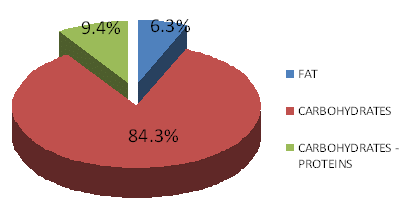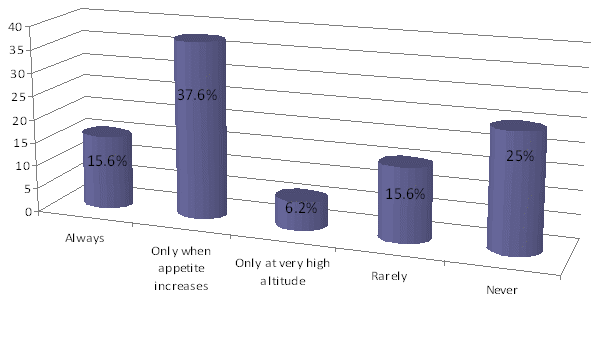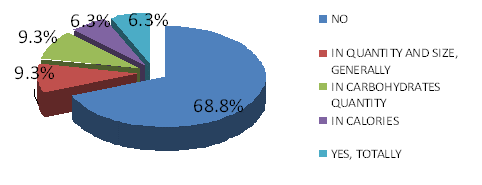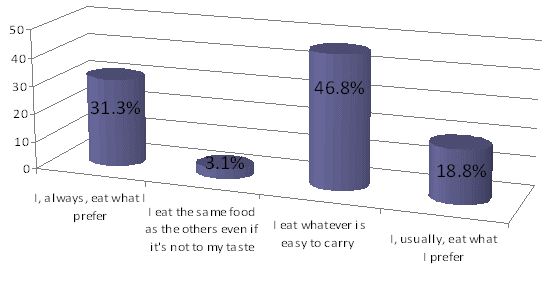EIRINI MANOUSOU, EIRINI ARGIRIADOU, ALEXANDROS ILIADIS,
FOTIOS MAVROVOUNIOTIS, ANNA TSILIGIROGLOU-FACHANTIDOU
Department of Physical Education and Sport Sciences
Aristotle University of Thessaloniki
Mailing Address: Fotios Mavrovouniotis, Assistant Professor, Department of Physical Education and Sport Sciences, Aristotle University of Thessaloniki, 57001 Thermi Thessaloniki,Greece
tel. ++30 2310992187 or mobile: ++30 6947521795,
e-mail: mavrov@phed.auth.gr
The aim of the present research is to examine mountaineers’ diet parameters and the relevant bodily state during their stay at a high altitude. For this purpose 32 amateur mountaineers, 22 men and 10 women, aged 32.82▒10.88 years, volunteered to participate in the research. The mountaineers were members of hiking clubs of Thessaloniki and Veria cities of Northern Greece. For data collection a questionnaire with questions (open and closed) concerning mountaineers’ somatometric and climbing characteristics, as well as dietary habits during their climbing was used. Data were analyzed with the Statistical Package for the Social Sciences v.17.0 for windows. From the results it was shown that 50% of mountaineers have observed a weight loss during their stay at high altitude. Most mountaineers who stayed at a high altitude 3.5-8 days observed a weight loss of 1-2 kg, while most mountaineers who stayed at a high altitude more than 15 days observed a weight loss of 7-10 kg. In addition, it is observed that a big percentage of the mountaineers (83.3%) have reported increased fatigue, while the 37.6% of the mountaineers mentioned that they always or/and many times experience reduced appetite. Moreover, mountaineers have a small number of meals per day during their stay at high altitude, as the largest percentage (45.2%) has only 2 meals per day. As for the main nutritional substance of diet, 84.3% mentioned that their diet at high altitude includes mostly carbohydrates, while an additional 9.4%, have also mentioned carbohydrates as well as proteins. Regarding the relative problems of food carrying at high altitude, a very high percentage of the participants (71.9%) mentioned difficulties in carrying food at high altitude, while 46.8% of mountaineers choose and eat food that is easy to carry, while only the 31.3% of the mountaineers always choose food that suited their taste. All the above data can solely or/and in combination justify in a big degree the observed weight loss. In conclusion, the aforementioned factors could restrict to a large degree, mountaineers performance and activity in extreme conditions that they face at high altitude.
Key-Words: climbing, food, habits, weight loss, fatigue, decreased appetite.
Introduction
Weight changes are one of the main problems that athletes of different sports such as rhythmic, gymnastics, wrestling, weightlifting, rowing or mountaineering etc., face (Burke, 2007; Gibbs et al., 2009; Manore et al., 2009; Dunford et al., 2008; AISN, 2009; Benardot, 2006). In regard to mountaineering the maintenance of athletes’ body mass is intended not only for better performance but there is also a very serious issue, the survival in such an extreme environment. The specific environmental conditions at high altitude including very low temperatures, dry air and hypoxia, could make any kind of exercise difficult to execute. It is also noted that the altitude plays an important role in weight loss. Exercise at a high altitude can lead to loss of fat and muscle mass. If a big amount of this weight loss is a muscle tissue, loss there would be potential impact on mountaineers’ ability when they climb (Powers et al., 1997). The phenomenon of mountaineers’ weight loss concerns the scientists. However, the precise altitude where weight loss occurs as well as the precise reasons that cause the weight loss are not fully known. The contribution of hypobaric hypoxia plays an important role although the physiological mechanisms are not clear (Lipll et al., 2010). In addition, appetite loss seems to be very important (Westerterp, 2001), while anorexia on the first phase of staying at a high altitude can lead to a 25-30% reduction in feeding (Sridharan & Rai, 1984). The reduction in energy intake is caused by a change in the appetite and in the attitude toward eating. The early appearance of satiety during a meal leads to a reduction in the meal’s quantity and is likely to be associated with the hypoxic environment. Anorexia can also be caused by the mountaineers’ disease, known as acute mountain sickness, which is a general term that refers to a combination of symptoms including headaches, anorexia, nausea, vomiting and malaise (Wolinsky, 1998). In addition, weight loss may be associated with the increase of basic metabolism and the consequent impairment of energy intake. Consequently, high energy consumption is required due to the difficulty level of the activity (Tanner & Stager, 1998) and due to the increase of the metabolic rate during exposure to a higher altitude, which mostly occurs at altitude 5.000m (Wolinsky, 1998; Westerterp, 2001), although it has been observed even at moderate altitude 2.000-4500m (Tanner & Stager, 1998). Extreme weather conditions also could be another cause of mountaineers’ weight loss (Martineau & Jacobs, 1988). Energy requirements are increased in cold environment due to the need for more heat, increasing difficulty of walking in the snow, the sloping ground, and the special clothing that is required and the load carried by each climber. Which is the best kind of diet for mountaineers is also a question. Carbohydrates are thought to be the preferred fuel because of their higher yield of ATP per mole of O2 (McClelland et al., 1998). Shivering, the basic mechanism of human body for heat production in cold environments (Martineau & Jacobs, 1988) can boost the burning of limited stores of glucose and glycogen up to six fold. So shivering is like siphoning off the last drops from the fuel tank (Jensen, 2010). This is another reason that makes carbohydrate consumption very important. Moreover personal food preferences and difficulty of finding and transporting food should be taken into account in the above possible causes of weight loss at a high altitude. From the study of the relevant literature it has been shown that there are several researches examining the issue of weight loss at a high altitude. However there are no research data in to our knowledge considering Greek mountaineers. For these reasons, the aim of the present study is to investigate the dietary habits and the associated state of the body weight of Greek mountaineers during their stay at high altitude.
Method
Sample: 32 amateur mountaineers, 22 men and 10 women, members of hiking clubs of Thessaloniki and Veria cities of Northern Greece volunteered to participate in the research, after the aim and the design of the research were described. Procedures were in agreement with ethical standards of the Declaration of Helsinki of the World Medical Association 2000. Criterion for mountaineers’ participation in the research was climbing altitude >1800m.
Material: For data collection a questionnaire with questions (open and closed) concerning mountaineers’ somatometric and climbing characteristics, as well as dietary habits during their climbing was used. The questions were created after the study of the relevant literature about the more serious issues preoccupying mountaineers as for their diet during their stay at high altitude (Haman et al., 2006; Benson et al., 2007; Powers et al., 1997; Tschop et al., 2001; Lipll et al., 2010; Pistilli et al., 2009; Stager et al.,1998; Simon-Schrass, 1992; Mariott et al., 1996; Askew, 1995; Westerterp, 2001; Westerterp et al., 2006; Netzer et al., 2007; Jensen, 2010). More specifically, mountaineers were asked to indicate sex, age, height and weight, years of involvement with the mountaineering and the maximum altitude of multi-day climbing or one-day climbing. In addition, there are questions about related weight loss, the kind of food and the frequency of meals, the changes in appetite and in fatigue and, also, about the difficulty of the food transferring during the stay at high altitude. The questionnaire was firstly used in a pilot study, where four mountaineers, two men and two women, students of Department of Physical Education and Sport Sciences, participated, with the help of which some questions were corrected and adjusted in order to be more easily understood.
Procedure: The questionnaires were given to mountaineers in their weekly meeting in the hiking club where each one was member. The first contact was made by telephone, where, after discussion with the club chairmen, an appointment was shut in order the mountaineers be informed about the purposes of research and the necessary instructions for completing the questionnaire by the researchers. A description of general requirements was given and, still, the aim of the research was described to the participants without any briefing relative to previous research findings. The instrument was also presented and the instructions were explained. The need for absolute honesty and precision was particularly emphasized, as well as the fact that questionnaires will be anonymous. All the mountaineers who agreed to participate in the research were then answered to the questionnaires. Questionnaires collection was lasted one month.
Statistical Analysis. The statistic packet SPSS/PC version 17.0 for windows was used. Descriptive analysis was used for the extraction of descriptive statistics.
Results
In Table 1, somatometric as well as mountaineering characteristics are presented. As it can be seen the mean altitude of climbing was 3683.6▒1357.85 m, while the mean altitude of multi-day climbing was almost the same (Table 1).
Table 1. Mountaineers characteristics
|
Somatometric characteristics |
Mountaineering characteristics |
||
|
Age (years) |
32.820▒10.88 |
Years involved with mountaineering |
1-30 |
|
Height (m) |
1.724▒0.085 |
Altitude of climbing (m) |
3683.6▒1357.85 |
|
Weight (kg) |
70.56▒12.836 |
Altitude of multi-day climbing (m) |
3579.92▒1370.78 |
According to mountaineers’ declaration the 50% have observed a weight loss during their stay at high altitude, while the other 50% didn’t notice any weight loss (Fig. 1).
Figure 1. Observation of weight loss at high altitude
As it is presented in Table 2, weight loss at high altitude seems to be increased in relation to extended stay at high altitude. So, it is obvious that the most mountaineers, who stayed at a high altitude 3.5-8 days observed a weight loss of 1-2 kg, while the most mountaineers who stayed at a high altitude more than 15 days observed a weight loss of 7-10 kg (Table 2).
Table 2. Observation of weight loss according with the climbing duration
|
Days |
Percentage of individuals |
||
|
|
1kg - 2kg |
2,5kg - 4,5kg |
7kg - 10kg |
|
1-3 d |
33.2% |
0% |
0% |
|
3,5-8 d |
20% |
13.6% |
0% |
|
≥15 d |
6.6% |
6.6% |
20% |
In addition, it is observed that a big percentage of the individuals (83.3%) have reported increased fatigue at high altitude, while 16.7% didn’t observe increased fatigue (Fig. 2).
Figure 2. Observation of increase in fatigue at high altitude
From the results was observed that a big percentage of the mountaineers (37.6%) mentioned that they experienced reduced appetite on many occasions at high altitude. However there is an almost equal percentage (37.5%) mentioning that they rarely felt appetite loss. Moreover the ╝ of the sample didn’t have such an experience (Fig. 3).
Figure 3. Observation of appetite decrease at high altitude
It is observed that mountaineers have a small number of meals per day during their stay at high altitude. The largest percentage (45.2%) mentioned having only 2 meals per day at high altitude, while only the 22.6% mentioned having >5 meals, including the elevenses and afternoon snack (Fig. 4).

Figure 4. Number of the consumed meals at high altitude
As for main nutritional substance of diet, the 84.3% of the participants in the research mentioned that their diet at high altitude includes mostly carbohydrates, while an additional 9.4%, also, mentioned carbohydrates as well as proteins (Fig. 5).

Figure 5. Main nutritional substance of diet at high altitude
Regarding the problems relatively the food carrying at high altitude, a very high percentage of the participants (71.9%) mentioned difficulties in carrying food at high altitude (Fig. 6).

Figure 6. Confrontation of problems relatively the food carrying at high altitude
Only 15.6% of the mountaineers increase always the calorie value of their diet as altitude inclines. However 37.6% mentioned increase in calorie value only when they feel increase appetite. Finally, 25% of mountaineers never increase the calorie value of their diet as altitude inclines (Fig. 7).
 Figure
7.
Calorie value increase in mountaineers’ diet
Figure
7.
Calorie value increase in mountaineers’ diet
As, for the observed differences in diet according to altitude and difficulty climb level, the 68.8% of the mountaineers report that their diet does not change according to altitude and difficulty in climbing level, while the 9.3% noticed differences in the quantity of carbohydrates (Fig. 8).

Figure 8. Differences in diet according to altitude and difficulty climb level.
In addition, the mountaineers’ highest percentage (46.8%) chooses food that is easy to carry, while only the 31.3% of the mountaineers always choose food that suits their taste (Fig. 9).

Figure 9. Mountaineers’ diet and preferable food at high altitude
Finally, in Table 3 is presented the daily water intake in regard to dehydration at high altitude.
Table 3. Daily water intake in regard to dehydration at high altitude
|
Water intake (lit) |
Dehydration confrontation |
||
|
Almost |
Rarely |
Never |
|
|
1-1.5 |
6.5% |
12.9% |
12.9% |
|
2-3 |
32.3% |
16.1% |
12.9% |
|
4 |
0% |
3.2% |
3.2% |
As it is presented in Table 3, the 32.3% of the mountaineers observed almost dehydration confrontation when the water intake is 2-3 lit. However, when the water intake was higher than 3 lit, there wasn’t observed dehydration problem in mountaineers.
Discussion
From the results of the present study as well as from bibliography review, weight loss seems to be an actual problem that mountaineers are forced to confront. More specifically, in the present study, 50% of the participants declared they had noticed weight loss during their stay at high altitude, while it has been observed that weight loss tends to increase in relation to longer duration at high altitude. In accordance to Hamad et al. (2006) mountaineers at high altitude (5000 m) lose weight. In a research of Benson et al. (2007) that studied nine men, highly qualified mountaineers, a decline in body weight after a stay of 7 weeks at a height of 5.200m to mountain Everest was noticed.
In addition, the present study is amongst other things an attempt to underline the various reasons that lead to weight loss. That which probably has the biggest affect in relation to maintenance or loss of body weight is the diet which each mountaineer followed. A high in energy output nutrition might restrict up to some point such a loss. Tsc÷p and Morrison (2001) in their research claim that weight loss is a fact at high altitude and can be restricted up to some extent by consuming a larger amount of calorie but cannot be totally avoided. In contradiction Bourrilhon et al. (2009) in their research in which they studied the effects of a surplus of proteins or carbohydrates showed that a diet rich in proteins or carbohydrates during physical exercise at medium altitude supports the mental ability but didn’t restrict loss of muscle mass or weight loss.
Sridharah and Rai (1984) support that anorexia during the first stage of duration at high altitude might lead to reduction in food consuming up to 25-30%. This fact is made obvious also from the present study as appetite loss in quite a high percentage of the subjects has been recorded. More specifically 37.6% of the subjects claim that they felt almost always a loss in appetite for food during their stay at high altitude. The mentioned above agree with the study of Westerterp-Plantenga et al. (1999) which expresses the opinion that exposure to hypoxic environment is connected to a change in the attitude towards food consumption and with appetite diminution. In addition Pistilli et al. (2009) claimed that there is a correlation between exposure to hypoxia and reduced muscle mass, as well as a subsequent diminution of exercise ability even though the exact mechanism is not totally understood. This fact can create problems for the human body, as indicated in a study done by Askew (1995) showing that insufficient food intake during body exercise for a long period of time in extreme environmental conditions could result in a negative energy and nitrogen balance as well as in dehydration. As a result there could be a disturbance in thermoregulation, ketosis, changes in the oxeobasic and electrolyte balance, as well as a depletion in the muscles glycogen storage.
Another phenomenon at high altitude is the increased fatigue as mentioned by 83,3% of the mountaineers in the present research, a fact that is expected due to the level of difficulty in this specific activity as well as the environmental conditions that are extremely harsh on the body. If we take into consideration all the facts mentioned above as well as the limited number of meals that most of the mountaineers mention (2-3 meals/day) it seems to be easy enough to have weight loss. In addition it is worth mentioning the difficulties which the mountaineers face in order to carry their food. The weight that the mountaineers have to carry with them and the difficulty in transporting the food during long term expeditions are the two main issues mentioned by climbers in the research. Generally speaking most of the climbers answered that they increase the calorie value of their meals in relation to altitude only when they feel increased desire for food while 68.8% answered that their nutrition level doesn't change if they climb on higher altitudes or if the activity is harder. Considering if the contents of the meal played any role in their preference the answer that drew our attention was the one that is easy to carry. This shows that it isn't always easy to combine the choice of food with the individuals taste and preference. It is obvious that the difficulty in transporting some kind of food at high altitude effects the actual nutrition of mountaineers.
As for water intake, it was found out that the participants in the present study raised their water intake about one liter during their stay at high altitude. This increase in water intake doesn't seem to be enough considering the fact that just the participation in any physical activity demands this specific raise in water intake. However, during mountain climbing the body confronts great difficulties and an additional raise in water intake is needed. In the present study, the 32.3% of the mountaineers observed almost dehydration confrontation when the daily water intake was 2-3 lit. However, when the water intake was higher than 3 lit, there wasn’t observed dehydration problem in mountaineers. In agreement Westerterp (2001) mentioned that there is a negative water balance during stay at high altitude, which however, is not the result, only, of difficulties in finding water since at high altitude the only source of waster is melting the snow, neither is the raise in water vapor loss through breathing (this loss is somehow balanced with the lowering of metabolism rhythm and use of suitable clothing). The same researcher claims that the first negative water balance is a mechanism of ability as it was noticed that individuals that had raise in water loss due to increased urination during the first days of exposure to high altitude presented less symptoms of the mountain sickness. Drinks high in carbohydrates are quite popular amongst the mountaineers, as 47.7% choose them as part of their fluid intake. It is quite interesting that even in this specific kind of food, carbohydrates seem to have a major importance. Specifically, the isotonic drinks are used quite often, a fact that leads to the conclusion that liquid in combination with a high energetic output offers valuable benefits.
For the question dealing with the kind of food mountaineers mainly consume during their expeditions, it was found out that the 84.4% choose carbohydrates. From the results of the daily food consumption list (which is a sample for one day in which all or most of the meals are consumed) it seems that: the mountaineer's breakfast does not differ much from an ordinary breakfast (for example cereal, bread with butter and honey). Between breakfast and lunch the climbers usually eat a small but rich in energy snack, such as chocolate, dried fruit etc. Lunch is mainly based on carbohydrates, usually being pasta or rice, while the afternoon snack is mostly a sweet or a fruit. Finally, for dinner most mountaineers choose again a meal made up from carbohydrates, usually combined with meat or ham salami and such. According to the mentioned above there is a surplus of carbohydrates in the meals as a main source of energy chosen by mountaineers during their stay at high altitude. This might occur for various reasons, such as, the quick form of energy that this kind of food provides, the fact that they are easy to carry at high altitudes, easy in preparation, as well as the fact that they can be kept for quite a few days without discomposing.
All the above data can solely or/and in combination justify in a big degree the observed weight loss at high altitude. More specifically, decreased appetite, increased fatigue due to the form of the activity, decreased number of meals, difficulty in transporting food, as well as deficiency of food choices could lead to weight loss. In addition, all the aforementioned factors could, also, restrict in a big degree mountaineers performance and activity in the extreme conditions they face at high altitude.
References
Australian Institute of Sport Nutrition - AISN. (2009). http://www.ausport.gov.au/ais/nutrition/factsheets/sports/rowing
Askew, E.W. (1995). Environmental and physical stress and nutritional requirements. American Society for Clinical Nutrition, 61: 631-637.
Benardot, D. (2006). Advanced sports nutrition. Human Kinetics, USA.
Benso, A., Broglio, F., Aimaretti, G., Lucatello, F., Ghigo, E., Grottoli, S. (2007). Endocrine and metabolic responses to extreme altitude and physical exercise in climbers. European Journal of Endocrinology, 157(6): 733-740.
Cerny, F.J., Burton, H.W. (2003). Exercise physiology for health care professionals (pp. 284-287). Human Kinetics, USA.
Consolazio, C.F., Matouse, L.O., Johnson, H.L., Daws, T.A. (1968). Protein and water balances of young adults during prolonged exposure to high altitude (4.300m). American Journal of Clinical Nutrition, 21(2): 154-161.
Dunford, M., Doyle, J.A. (2008). Nutrition for sports and exercise. Thomson Learning INC, Belmont.
Gipps, A.E., Pickerman, J., Sekiya, J.K. (2009). Weight management in Amateur Wrestling. American Orthopedic Society for sports Medicine, 1(3): 227-230.
Jensen, C.D. (2010). Nutrition and training challenges at high altitudes. www. powerbar.com
Hamad, N., Travis, S.P. (2006). Weight loss at high altitude: pathophysiology and practical implications. European Journal of Gastroenterol Hepatol, 18(1): 5-10.
Lippl, F.J., Neubauer, S., Schipfer, S., Lichter, N., Tufman, A., Otto, B., Fischer, R. (2010). Hypobaric hypoxic causes body weight reduction in obese subjects. Obesity. 18(4): 675-681.
Manore, M.M., Meyer, N.L., Thomson, J. (2009). Sports nutrition for health and performance. Human Kinetics, USA.
Martineau, L., Jacobs, I. (1988). Muscle glycogen utilization during shivering thermogenesis in human. Journal of Applied Physiology, 65(5): 2046-2050.
McClelland, G.B., Hochachko, P.W., Weber, J.M. (1998). Carbohydrate utilization during exercise after high-altitude acclimation: A new perspective. The National Academy of Sciences, 95(17): 10288-10293.
Pistilli, E.E., Bogdanovich, S. Mosqueira, M., Lachey, J., Seehro, J., SKhurana, T.S. (2009). Pretreatment with a soluble activin type IIB receptor/Fc fusion protein improves hypoxia-induced muscle dysfunction. American Journal of Physiology, 298(1): R96-R103.
Powers, S.K., Howley, E.T. (1997). Exercise physiology theory and applications to fitness (pp. 440-451). Mc Grow Hill, USA.
Sridharan, K. Rai, R.M. (1984). Nutritional Aspects of high altitude and Snow band areas. Defense Science Journal, 34(4): 429-441.
Tanner, D.A., Stager. J.M. (1998). Partitioned weight loss and body composition changes during a mountaineering expedition: a field study. Wilderness & Environmental Medicine, 9(3): 143-52.
Tsc÷p, M., Morrison, K.M. (2001). Weight loss at high altitude. Advances in Experimental Medicine and Biology, 502: 237-47.
Westerterp, K.R. (2001). Energy and Water Balance at high altitude. News In Physiological Sciences, 16(3): 134-137.
Westerterp-Plantenga, M.S., Westerterp, K.R., Rubbens, M., Verwegen, C.R.T., Richeler, J.P., Gardette, B. (1999). Appetite at high altitude [operator Everest III (Comex-971)]: a simulated ascent of Mount Everest. Journal of applied physiology, 87(1): 391-399.
Wolinsky,I. (1998). Nutrition in exercise and Sport (third edition) (pp. 608-613). CRC Press LLC, USA.